
Copyright © 2017 by Solution Tree Press
Materials appearing here are copyrighted. With one exception, all rights are reserved. Readers may reproduce only those pages marked “Reproducible.” Otherwise, no part of this book may be reproduced or transmitted in any form or by any means (electronic, photocopying, recording, or otherwise) without prior written permission of the publisher.
555 North Morton Street
Bloomington, IN 47404
800.733.6786 (toll free) / 812.336.7700
FAX: 812.336.7790
email: info@SolutionTree.com
SolutionTree.com
Visit go.SolutionTree.com/mathematics to download the free reproducibles in this book.
Printed in the United States of America
Solution Tree
Jeffrey C. Jones, CEO
Edmund M. Ackerman, President
Solution Tree Press
President: Douglas M. Rife
Editorial Director: Tonya Maddox Cupp
Managing Production Editor: Caroline Weiss
Senior Editor: Amy Rubenstein
Copy Chief: Sarah Payne-Mills
Media Editor: Peggie Howard
Copy Editor: Ashante K. Thomas
Proofreader: Elisabeth Abrams
Text and Cover Designer: Abigail Bowen
Compositor: Laura Cox
Editorial Assistants: Jessi Finn and Kendra Slayton
Writers: Juli K. Dixon, Edward C. Nolan, Thomasenia Lott Adams, Jennifer M. Tobias, and Guy Barmoha

iii Table of Contents Reproducible pages are in italics. Notes to the Facilitator 1 Conducting the Workshop . . . . . . . . . . . . . . . . . . . . . . . . . . . . . . . . . . 2 Video Program . . . . . . . . . . . . . . . . . . . . . . . . . . . . . . . . . . . . . . . . 3 Other Resources . . . . . . . . . . . . . . . . . . . . . . . . . . . . . . . . . . . . . . . 3 Print 3 Video . . . . . . . . . . . . . . . . . . . . . . . . . . . . . . . . . . . . . . . . . . . . . . . . 3 Workshop Overview at a Glance 5 Workshop Steps and Teaching Suggestions: Statement of Purpose 7 Learning Objectives . . . . . . . . . . . . . . . . . . . . . . . . . . . . . . . . . . . . . 7 Program Overview . . . . . . . . . . . . . . . . . . . . . . . . . . . . . . . . . . . . . . 7 Materials . . . . . . . . . . . . . . . . . . . . . . . . . . . . . . . . . . . . . . . . . . . 7 Activities . . . . . . . . . . . . . . . . . . . . . . . . . . . . . . . . . . . . . . . . . . . 8 Welcome and Opening 8 Exploring a Good Task . . . . . . . . . . . . . . . . . . . . . . . . . . . . . . . . . . . . . . . 9 Using the TQE Process 11 Choosing Tasks . . . . . . . . . . . . . . . . . . . . . . . . . . . . . . . . . . . . . . . . . . 12 Exploring Fractions as Learners 13 Using Arrays to Support Making Sense of Multiplication Strategies . . . . . . . . . . . . . . . . 14 Connecting Arrays to Area 15 Closing . . . . . . . . . . . . . . . . . . . . . . . . . . . . . . . . . . . . . . . . . . . . . . 15 Reproducible Handouts 17 Task 1: Exploring a Good Task 18 Classroom Video Analysis Tool 19 Task 2: Using the TQE Process 20 Types of Questions Capture Tool 21 TQE Analysis Tool . . . . . . . . . . . . . . . . . . . . . . . . . . . . . . . . . . . . . .22 Task 3: Exploring Fractions as Learners . . . . . . . . . . . . . . . . . . . . . . . . . . . .23 Task 4: Using Arrays to Support Making Sense of Multiplication Strategies . . . . . . . . . . . . 24 Task 5: Connecting Arrays to Area . . . . . . . . . . . . . . . . . . . . . . . . . . . . . . . 25
Notes to the Facilitator

This workshop provides participants with the opportunity to engage in mathematics as learners in order to make sense of that mathematics for teaching. This workshop is intended to support teachers and teacher leaders to situate this knowledge within learning progressions, classrooms, and the TQE (tasks, questioning, and evidence) process. The TQE process describes three key aspects of the teacher’s role: (1) selecting, adapting, or creating worthwhile tasks to address a specific learning goal; (2) using targeted and appropriate questioning strategies to support all learners; and (3) collecting evidence of students’ conceptual understanding and misconceptions related to the learning goal.
This workshop addresses three specific goals.
1. To explore meaningful tasks as learners of mathematics for teaching
2. To make sense of the TQE process
3. To create a shared vision of classrooms where teachers are supporting the TQE process and students are engaged in meaningful mathematics learning experiences
These goals are accomplished using challenging tasks for teachers, questions related to using those tasks in classrooms, and classroom video where the tasks are modeled during instruction. Series authors introduce classroom video by highlighting important aspects of this workshop specifically and making sense of mathematics for teaching in general.
The workshop is divided into eight segments, and the corresponding video clip titles are listed in parentheses.
1. Welcome and Opening: This segment describes the series’ organization around a common structure—The Challenge, The Progression, The Mathematics, The Classroom, and The Response. Participants discuss the importance of making sense of mathematics for teaching in their own teaching and related roles.
2. Exploring a Good Task (Defining and Classifying Squares and Rectangles): Participants discuss the importance of making sense of mathematics for teaching through an exploration of specific quadrilaterals. Participants discuss their responses to the task and how they might support it during instruction. Video of students engaging in a task around a similar topic follows this discussion. Participants debrief regarding what they expected to see in the classroom episode and what actually occurred.
3. Using the TQE Process (Comparing Fractions by Focusing on Numerators)—Participants solve a fraction comparison task that might be challenging to them. They discuss their solution processes and anticipate how students might solve the same task. Participants then watch the video of a Making Sense of Mathematics for Teaching Grades 3–5 series’ author defining the TQE
1
process and sharing its importance. The participants go on to watch the classroom video using the same task they just explored. Discussion is supported following the video connecting what the participants observed to the TQE process and the importance of planning for the TQE process.
4. Choosing Tasks (Using Place Value Understandings to Model Decimals): This segment starts with participants viewing the classroom video. Participants respond to prompts related to why the teacher chooses the tasks; why he uses the questioning he uses; and what evidence he is able to collect from the overall process.
5. Exploring Fractions as Learners (Comparing Fractions Using a Benchmark): This segment provides participants with the opportunity to design tasks given a learning goal. Participants determine tasks for addressing fraction comparison strategies. Once those tasks are designed, shared, and discussed, participants view a classroom video related to the same learning goal and compare the tasks.
6. Using Arrays to Support Making Sense of Multiplication Strategies (Modeling Multiplication Strategies): In this segment, participants explore using arrays as a means for making sense of multiplication fact strategies. They will connect this exploration by considering how learning develops over time in conjunction with the next video.
7. Connecting Arrays to Area (Finding Area in Context): In this segment, participants connect two seemingly unrelated topics, using arrays to make sense of multiplication fact strategies in the previous video and decomposing shapes to find area. Participants discuss how the topics are related and fit into a learning progression that crosses grades.
8. Closing: In this segment, participants reflect on what they have learned in the workshop and plan for next steps.
Conducting the Workshop
This workshop is designed to last about eight hours. It can be scheduled for a single day consist ing of two sessions or be scheduled over two days. All the professional development materials you need to conduct this workshop—the facilitator’s guide with detailed teaching suggestions and the video resources—are provided in this package.
To conduct a successful learning event, please consider the important issues that follow.
Preparation: Please view the entire video program, read all materials, and complete all activities yourself before leading the workshop.
Location: The workshop should take place in an area that is large enough for individual, team, and whole-group work.
Equipment: You will need a DVD player, a projector, and one or more monitors. You will also need a computer projector to show PowerPoint slides.
Reproducible handouts and PowerPoint presentation: Reproducible handouts are included with this guide (starting on page 18 and on the CD). The handouts should be duplicated before the workshop begins and be distributed to participants according to the workshop instructions. A PowerPoint presentation is also included (on the CD).
2 MAKING SENSE OF MATHEMATICS FOR TEACHING GRADES 3 5
Additional equipment: You will also need flip charts, chalkboards, or whiteboards with appropriate writing materials (blank paper and markers, pens, or pencils) to conduct the workshop.
Refreshments: The workshop’s agenda should include one or more breaks at which beverages are offered. Snacks and lunch are optional, but water should be available throughout the workshop.
Video Program
This workshop incorporates a video program that is approximately forty-two minutes in length. Video will be used throughout the workshop. It is used to introduce some segments and to close others. Most often, the video provides both a suggestion for what to look for during planning and instruction as explained by series authors as well as an example of what model instruction looks like in the classroom through authentic classroom video. It might be helpful to replay certain video portions for participants and also to pause so participants can reflect on what they have seen.
Other Resources
Print
Making Sense of Mathematics for Teaching Grades K–2
Making Sense of Mathematics for Teaching Grades 6–8
Making Sense of Mathematics for Teaching High School
Video
Making Sense of Mathematics for Teaching Grades K–2: The TQE Process
Making Sense of Mathematics for Teaching Grades 6–8: The TQE Process
Making Sense of Mathematics for Teaching High School: The TQE Process
Notes to the Facilitator 3
Workshop Overview at a Glance
15–30
45–60

60–90
Welcome and Opening
Exploring a Good Task (Defining and Classifying Squares and Rectangles)
Using the TQE Process (Comparing Fractions by Focusing on Numerators)
Slides 1–2
Slides 3–11
“Task 1: Exploring a Good Task”
“Classroom Video Analysis Tool”
Slides 12–20
“Task 2: Using the TQE Process”
“Types of Questions Capture Tool”
“TQE Analysis Tool”
45–60
60–90
45–60
45–60
30–45
Choosing Tasks (Using Place Value Understandings to Model Decimals)
Exploring Fractions as Learners (Comparing Fractions Using a Benchmark)
Using Arrays to Support Making Sense of Multiplication Strategies (Modeling Multiplication Strategies)
Connecting Arrays to Area (Finding Area in Context)
Closing
Slides 21–23
“TQE Analysis Tool”
Slides 24–27
“Task 3: Exploring Fractions as Learners”
“Classroom Video Analysis Tool”
Slides 28–32
“Task 4: Using Arrays to Support Making Sense of Multiplication Strategies”
“Classroom Video Analysis Tool”
Slides 33–36
“Task 5: Connecting Arrays to Area”
“TQE Analysis Tool”
Slides 37–39
5
Time (in minutes) Segments
and
PowerPoint Slides
Reproducible Handouts
Workshop Steps and Teaching Suggestions: Statement of Purpose

It is important for participants to engage in productive struggle around high-cognitive-demand tasks as learners and then to plan for how those same tasks might be supported during instruction through the use of appropriate questioning as teachers. Use the videos to explore how evidence can be collected as part of the formative assessment process during instruction.
Learning Objectives
After viewing the video and participating in the activities for the workshop, participants will be able to:
Identify high-cognitive-demand tasks
Adapt existing low-cognitive-demand tasks to make them high cognitive demand
Plan questions to support students to engage in productive struggle around high-cognitivedemand tasks
Collect evidence of student conceptions and misconceptions through productive questioning while students work to solve tasks
Program Overview
The video associated with this workshop offers perspectives from Juli K. Dixon, Edward C. Nolan, Thomasenia Lott Adams, and Jennifer M. Tobias—all authors of Making Sense of Mathematics for Teaching Grades 3–5 —related to mathematics content knowledge for teaching, the TQE process, and progressions for learning mathematics. Juli, Edward, Thomasenia, and Jennifer model best practices through authentic classroom video to create a shared image of students engaged in meaningful experiences related to mathematics learning.
Materials
Video program: Making Sense of Mathematics for Teaching Grades 3–5: The TQE Process
PowerPoint presentation slides
Reproducible handouts:
“Task 1: Exploring a Good Task”
“Classroom Video Analysis Tool”
7
“Task 2: Using the TQE Process”
“Types of Questions Capture Tool”
“TQE Analysis Tool”
“Task 3: Exploring Fractions as Learners”
“Task 4: Using Arrays to Support Making Sense of Multiplication Strategies”
“Task 5: Connecting Arrays to Area”
Flip charts, chalkboards, or whiteboards with appropriate writing materials
Activities
It is best to follow the activities as outlined in the workshop teaching suggestions and pause the video when prompted. After showing each video clip, allow participants time to comment or ask questions about the material. If requested, you can replay video portions as participants consider the questions and activities.
Welcome and Opening
1. Welcome participants to the workshop, and introduce yourself and anyone else serving as a workshop host, cofacilitator, or organizer.
2. If participants do not know one another well, conduct an icebreaker activity. Ask participants to form pairs and interview each other for about five minutes. Then ask the pairs to introduce each other to another pair, stating the person’s name, something interesting or different about the person, and what the person hopes to gain from the workshop.
3. Begin the workshop showing PowerPoint slide 1, then begin the DVD as Juli discusses the need for making sense of mathematics for teaching. Juli describes how the text is organized as well as how teachers experience mathematics tasks within the text as learners and then as facilitators of mathematics learning.
4. At the “Pause for group work” screen, have participants provide their perspectives on their role in this process. Use the following questions as a guide.
When was the last time you experienced mathematics as a learner?
Where are you in understanding the progression of the 3–5 standards?
What should those standards look like in a classroom? Who decides?
How do you respond to students when students do or do not understand?
What questions do you ask to assess students’ understanding in relation to a specific standard?
5. Show slide 2 to provide a general overview of the session goals. Within the session, participants will explore various mathematics tasks as learners, make sense of those tasks through the TQE process, and create a shared image of classrooms where teachers use the TQE process to ensure students are engaged in meaningful mathematics learning experiences.
8 MAKING SENSE OF MATHEMATICS FOR TEACHING GRADES 3 5
Exploring a Good Task
This segment is designed to help participants see the importance of planning in a collaborative team.
1. Show slide 3 and provide participants with the handout “Task 1: Exploring a Good Task.” The workshop’s first task is designed to help participants see the importance of a good task.
2. Show slide 4. Using the handout, ask participants to draw a square and then ask them to compare their squares to what others drew.
3. Show slide 5 and ask participants to identify which square most closely resembles their own. They will likely say C. Have participants discuss if A, B, or both are also squares or not and why. Indicate they need to be careful of this or students will not recognize A or B as squares also.
4. Show slide 6 and ask participants to draw a rectangle and compare their rectangles to what others drew.
5. Show slide 7 and ask participants to identify which rectangle most closely resembles their own. They will likely have drawn a rectangle like shape B, but some will still have drawn one like A or C. Remind them to provide examples other than those with horizontal bases. Then ask participants if any of them stopped after drawing the square because they already had a rectangle. This should cause participants to pause.
Then ask them if they think third-grade students know the relationship between rectangles and squares. Ask them how they might design a task to find out. This should result in a good conversation among participants. Ask what they think third-grade students would do if they were asked to make a rectangle when they had already made a square if participants do not suggest this.
6. Show slide 8 and discuss the value of using common tasks and building a shared vision on your team.
7. Click on “Next Segment” in the video and show the interview of Juli discussing the importance of using video to create a shared image of classroom instruction. Pause the video at 51 seconds.
8. Discuss the value of being able to observe common classroom instruction to clarify effective mathematical instructional practices.
9. Show slide 9, distribute the “Classroom Video Analysis Tool” handout, and ask “How do the teacher moves support students to engage with a challenging task?” Allow participants to use the handout to capture what they see in the video.
10. Start the video clip “Defining and Classifying Squares and Rectangles.” Play the video to the “Pause for group work” screen or pause the video throughout to discuss teacher strategies to develop student thinking, such as allowing students to feel safe to make errors, develop understanding without directly telling, and having students make sense of other students’ thinking. Have participants discuss what they noticed after the video is over. Suggested pauses:
Pause the video at 5:30— After the students describe the relationship between a square and a rectangle. At this point, some participants may be saying that the teacher is lucky to have a student actually say something like that; however, it is important to let participants
Workshop Steps and Teaching Suggestions: Statement of Purpose 9
know that after the teacher asks the groups to discuss, she listens to the group discussions and allows a student that had the concept explain it to the class.
The next teacher move is to ask another student to repeat what was just said about squares and rectangles. This teacher move serves two purposes: (1) it allows other students to put the response in their own words to help them better understand the concept and (2) the move also lets students know that listening to their classmates is just as important as listening to the teacher. Students get trained to only wait for the teacher to repeat something and not put importance to what other students are saying if the teacher is the only one repeating correct responses.
Pause the video at 6:00— Notice that this task was not one that was prepared ahead of time. The teacher asks all students to make a square that is not a rectangle based on a student’s response. A teacher’s ability to design tasks on the spot directly comes from his or her own deep understanding of the content as well as knowing the common errors that arise in students’ thinking. Participating in workshops like this and reading and interacting with books like Making Sense of Mathematics for Teaching titles allow teachers to build their content knowledge as well as learn those common errors and ways to respond to them. Bringing these experiences to their school-based professional learning community enables teachers to continue to build on their understanding and share with, as well as learn from, their peers.
11. Show slide 10 and ask participants “What did you notice?” and if the classroom video was what they anticipated. Discuss the importance of using classroom video to develop a shared understanding and vision of the mathematics and how to support that shared understanding and vision in the classroom. After this discussion and after entertaining participants’ questions, ask “How did the teacher help students engage in a challenging task?” Participants should indicate that the teacher did not give away the answers but rather assessed for understanding and then asked probing questions to guide students to this important relationship with quadrilaterals that is often challenging for students to grasp.
12. Show slide 11 and ask participants “What did the teacher learn about students’ conceptions?”
Participants should see that many students had a faulty definition for rectangle—that it must have two long sides and two short sides. This led students to struggle with the relationship between squares and rectangles.
Participants should conclude that students had a solid definition for squares. There are many good ideas for next steps, but one should be that students should be exposed to many examples of rectangles including those with different orientations and those that are squares. The teacher should anticipate and address similar misconceptions with the relationship between rectangles and parallelograms, rhombuses and parallelograms, and rhombuses and squares.
10 MAKING SENSE OF MATHEMATICS FOR TEACHING GRADES 3 5
Workshop Steps and Teaching Suggestions: Statement of Purpose
Using the TQE Process
This segment is designed to help participants see the value of using the TQE process by being intentional about selecting tasks, asking students targeted and productive questions, and collecting evidence of students’ conceptions and misconceptions.
1. Show slide 12 then show slide 13. Have the participants read and discuss the TQE process, and then watch the interview with Thomasenia describing it.
2. Show slide 14. Then click on “Next Segment” to resume video of Thomasenia. Pause the video at 2:00.
3. Show slide 15 and distribute the “Task 2: Using the TQE Process” handout. Allow participants time to complete the problem. Instruct them not to use common denominators or decimals to solve. Some participants will find this problem to be challenging unless they see that both pizzas have one piece left over. By comparing that one piece, 1/6 to 1/7, the 5/6 and 6/7 can also be compared. Participants should discuss their solution strategies.
4. Distribute the “Types of Questions Capture Tool,” show slide 16, and have participants discuss what questions they might ask when teaching this problem to their students. Have participants complete the handout’s middle column. What questions might they pose to get students to reason about one piece missing for this problem?
5. Continue the video, showing the clip “Comparing Fractions by Focusing on Numerators.”
6. After this video clip, show slide 17 and guide the participants to look for elements of the TQE process shown in the video.
7. Resume the video. You can also pause this segment throughout and have participants reflect on student strategies, errors and what the teacher did to facilitate errors, and the order of calling on students. Suggested pauses:
Pause at 3:13— Ask the participants why the teacher asked the students to first explain why they think Mark ate more pizza.
Pause at 3:46—The student states that when you cut the pizza into more pieces then you have smaller pieces to eat. You may want to ask the participants when students learn that concept. It is actually a concept that they should have learned in first grade. As a teacher, knowing the progression of standards through grade levels is important when selecting tasks.
Pause at 4:15— Notice how the teacher goes back to the student who had the original misconception to see if the other student’s response helped him to clear up his misunderstanding. Then the teacher allowed another group to explain using fraction circles. This is done to allow students who need the visuals to help make sense of the comparison.
Pause at 6:30—The teacher asks a certain group to explain its thinking. This is because the teacher has the task’s goal in mind and believes that this group has the desired analysis in mind. This is an attempt to get the whole class to see the strategy being used, that of comparing what is left of the pizza.
11
8. Show slide 18 and have participants revisit the questions they created on their “Types of Questions Capture Tool.” Have them reflect on what type of question they posed—a question that would only result in the answer, a question that would generate discussion, a question that would require students to explain, or a question that would move students’ thinking forward.
9. Show slide 19 and distribute the “TQE Analysis Tool” handout. Have participants reflect on the TQE process, and ask participants what they have observed in the classroom videos. Refer participants to the “TQE Analysis Tool” to capture their thoughts in reference to the process for this video. After this discussion and after entertaining participants’ questions, ask participants how the teacher incorporated the TQE process in instruction. Ask why the teacher sequenced the tasks the way she did.
10. Show slide 20 and ask participants “How did the teacher discover students’ misconceptions, and what do you think should be done next?” Participants’ responses could include that students use the concepts developed from the first task to make sense of the second task, and that the teacher uses questions to access the thinking of students at different mastery levels. The evidence that the teacher collects is that some students begin with misconceptions but then come to a good understanding. Some students have early understanding of fraction comparison but need more advanced strategies. Finally, some students make sense of the challenging task.
Choosing Tasks
This segment is designed to help participants see the value of selecting tasks to build understanding and to collect evidence of student conceptions and misconceptions.
1. Show slide 21. Click on “Next Segment” in the video and show Jennifer discussing the authors’ experience and selection of tasks. This segment is to consider the selection of rich and deep tasks to aid in students’ mathematics development. Pause the video at 32 seconds.
2. Show slide 22 and ask participants to pay attention to the tasks the students are asked to solve including the numbers given in the problem and the order they are presented. Have participants pay special attention to what evidence that teacher can gather from the tasks. Resume the video at the clip “Using Place Value Understandings to Model Decimals.”
3. Pause the video at 3:01. Notice how the teacher shows a student’s common error. The teacher could have seen this happen during the class period. However, if the teacher did not see this occur, he may have brought it up anyway. The goal is to expose students to common errors so when they think through the problems they can reason past them. Bringing common errors to the forefront allows students the time, in a nonthreatening environment, to feel comfortable about making mistakes and learning from them. Play the remainder of the video clip to the “Pause for group work” screen.
4. Show slide 23. Ask participants “What did you notice?” and “Was the classroom video what you anticipated?” After this discussion and after entertaining participants’ questions, ask “How did the teacher incorporate the TQE process in instruction?” Refer participants to the “TQE Analysis Tool” to capture their thoughts in reference to the process for this video. Ask “Why
12 MAKING SENSE OF MATHEMATICS FOR TEACHING GRADES 3 5
did the teacher sequence the tasks the way he did?” Then ask “Would you have done anything differently in the lesson?”
Exploring Fractions as Learners
This task is designed to help explore mathematics as a learner.
1. Show slide 24. Distribute the “Task 3: Exploring Fractions as Learners” handout.
2. Click on “Next Segment” in the video showing Edward describing the teacher as learner. Pause the video at 35 seconds. Explain that in this section participants will be learners.
3. Show slide 25. Pose the ordering fractions problem and give participants some space to make sense of this independently before working together. Check to be sure they are not finding common denominators or changing fractions to decimals. Also, check that they are using strategies that are definitive.
Note to facilitator: The order of the fractions from least to greatest is 5/11, 4/7, 4/5, 5/6, 9/8. Five-elevenths is the only fraction less than ½; therefore, it is the least. Nine-eighths is the only fraction greater than 1; therefore, it is the greatest. The fraction 4/7 is less than 4/5 because the latter has the same numerator (same number of pieces), and fifths are larger pieces than sevenths. The fraction 4/5 is less than 5/6 because each is missing one piece. Since 1/6 is less than 1/5 this means that 5/6 is missing less; therefore, it is the greater fraction.
4. Have participants share strategies for ordering the fractions. Model and teach the lesson as if they are students in the classroom. Ask questions to guide their thinking. Now challenge the participants to come up with a new set of five fractions that require using each comparison strategy here (compare to ½, compare common numerators, compare common denominators, compare to 1).
5. Show slide 26 to set up the lens through which to watch the video.
6. Distribute the “Classroom Video Analysis Tool” handout and resume the video, showing the video clip “Comparing Fractions Using a Benchmark.” Have participants focus on how the teacher guides students to make sense of the fraction comparison strategies. Pause the video to discuss student strategies, how the teacher facilitates the discussion, and how the teacher introduces reasoning skills to the class.
7. Pause at 2:39. At this point, a student has explained comparing two fractions correctly using common denominators. However, the teacher’s goal is for them to compare the fractions to ½; notice how the teacher introduces the strategy of comparing to ½ by making it seem as if it came from another student. This may have been the case or maybe not; however, it is our experience that students are more likely to use or try to make sense of strategies that they perceive come from other students. The questions that immediately follow allow the students to make sense of this strategy. Resume the video and play to the “Pause for group work” screen.
8. Even though the lesson’s second task—comparing 4/5 to 4/9—can use several strategies, the teacher’s moves get the class to use the strategy of comparing to ½ to get the students to make sense of the lesson’s goal.
Workshop Steps and Teaching Suggestions: Statement of Purpose 13
9. Show slide 27. Also ask participants “What did you notice?” and “What questions do you have?” after this discussion and after entertaining participants’ questions. Ask “Why did the teacher sequence the tasks the way she did?”
Using Arrays to Support Making Sense of Multiplication Strategies
This segment is designed to help explore teaching with coherence and progressions.
1. Show slide 28. Distribute the “Task 4: Using Arrays to Support Making Sense of Multiplication Strategies” handout and display slide 29. Have participants solve the array problem. They should make an array with 7 rows and 6 objects in each row. Have participants write an expression to represent the array. They should write 7 × 6 rather than 6 × 7 because with an array, the first factor represents the number of rows.
2. Show slide 30. When asked to break apart the array to use other facts to find 7 × 6, participants will likely break the array into five rows and then two rows or to find 5 × 6 and 2 × 6. They might make a vertical column after the fifth column to find 7 × 5 and 7 × 1. Have participants use symbols to represent their strategies. The two shared here would be represented as (7 × 6) = (5 × 6) + (2 × 6) = 30 + 12 = 42 and (7 × 6) = (7 × 5) + (7 × 1) = 35 + 7 = 42. If time allows, link this discussion to the distributive property of multiplication and discuss other properties, specifically, the associative property of multiplication and the commutative property of multiplication.
3. Show slide 31. Tell participants that they will watch a third-grade class using arrays for the same problem.
4. Provide the “Classroom Video Analysis Tool” handout. Tell participants to focus on how the teacher guides the students to connect arrays to expressions.
5. Click on “Next Segment” to play the classroom video clip “Modeling Multiplication Strategies.”
6. Pause the video at 2:55. Ask “Why did the teacher ask the class to use the array to count by 5s?” Continue the video to the “Pause for group work” screen.
7. Show slide 32. Also ask participants “Was the classroom video what you anticipated?” After this discussion and after entertaining participants’ questions, ask “How did the teacher connect arrays to the break-apart strategy?”
8. Click on “Next Segment” to show Edward discussing content progressions.
9. Pause the video at 24 seconds. Then ask participants “What might a focus on arrays connect to in later grades?” Responses could include multidigit multiplication. If nobody suggests finding area, ask participants how these topics might be connected.
Connecting Arrays to Area
This segment is designed to help explore teaching with coherence and progressions to solve area problems.
14 MAKING SENSE OF MATHEMATICS FOR TEACHING GRADES 3 5
1. Display slide 33 and distribute the “Task 5: Connecting Arrays to Area” handout. Show slide 34. Challenge participants to solve the area problem first individually and then have them share their strategies in groups. The goal is to find different ways to solve this problem by decomposing the areas into different areas. Ask participants “How does this compare to breaking apart arrays?”
2. Show slide 35. Prepare the participants to focus on how the next classroom video is similar to the previous classroom video focused on arrays.
3. Resume the video and show the video clip “Finding Area in Context.” You can play the entire classroom video or pause to make connections to the previous video. It’s suggested the facilitator pause at 2:52. The teacher allows students to break apart the area of the pool in different ways encouraging them to do the problem in a way that makes sense to them. This is similar when allowing students to break apart numbers in multiplication problems. Students should be allowed to break apart the numbers in ways that make sense to them, and allowing them to listen to other students’ reasoning will give them more understanding of number sense as they try to make meaning. Resume the video and play to the “Pause for group work” screen.
4. Show slide 36 and ask participants if the classroom video was what they anticipated. After this discussion and after entertaining participants’ questions, ask what other topics cross grade bands in similar ways. Refer participants to the “TQE Analysis Tool” to capture their thoughts in reference to the TQE process for this video.
Closing
1. Show slide 37 and review the TQE process before revisiting the goals. Allow participants time to think of a recent lesson they taught and apply the TQE process to that lesson.
Will they use the same tasks as they used before, or will they change or reorder their tasks?
What questions would be best to elicit explanation, critical thinking, and discussion?
How will they gather evidence to learn what their students understand, or what they have misconceptions with?
Lastly, what will you do with the evidence you gathered? How will it form your future instruction?
Teachers should use this time to reflect on previous lessons; if time permits, they should reconstruct a lesson plan with the TQE process in mind.
2. Show slide 38 and review the goals.
3. Click on “Next Segment” in the video. Edward describes the book series and professional development program associated with the book series.
4. Show slide 39. Ask participants what their biggest takeaway was from the workshop and how they will use what they learned.
5. Ask the participants what kind of support they might need as they implement the things they have learned during the workshop.
Workshop Steps and Teaching Suggestions: Statement of Purpose 15
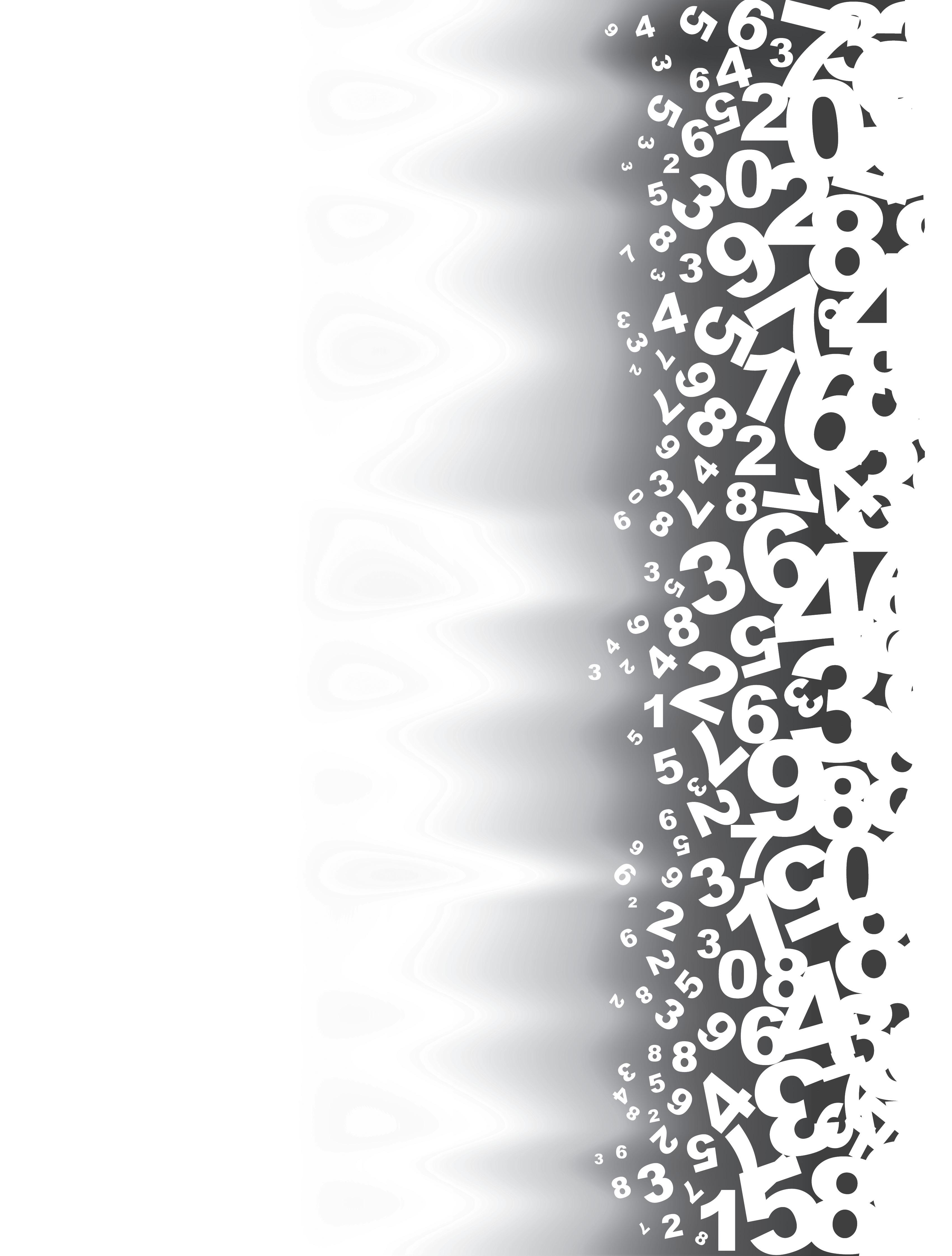
REPRODUCIBLE HANDOUTS
Draw a square.
Task 1: Exploring a Good Task
Draw a rectangle.
Making Sense of Mathematics for Teaching Grades 3–5: The TQE Process © 2017 Solution Tree Press • SolutionTree.com Visit go.SolutionTree.com/mathematics to download this free reproducible.
REPRODUCIBLE 18
REPRODUCIBLE 19
Classroom Video Analysis Tool
Describe the student discourse.
Describe the teacher actions that support student engagement.
Which Mathematical Practices are emphasized?
What expectations (spoken or understood) are communicated to the students?
Making Sense of Mathematics for Teaching Grades 3–5: The TQE Process © 2017 Solution Tree Press • SolutionTree.com Visit go.SolutionTree.com/mathematics to download this free reproducible.
Task 2: Using the TQE Process
Solve the problem: Riley and Paige each bought a small cheese pizza for lunch. They were both very hungry. Riley ate 5/6 of her pizza, and Paige ate 6 /7 of her pizza. Who ate more pizza?
Making Sense of Mathematics for Teaching Grades 3–5: The TQE Process © 2017 Solution Tree Press • SolutionTree.com Visit go.SolutionTree.com/mathematics to download this free reproducible.
20
REPRODUCIBLE
Solution to a Problem
Types of Questions Capture Tool
Require Students to Explain
Generate Discussion
Making Sense of Mathematics for Teaching Grades 3–5: The TQE Process © 2017 Solution Tree Press • SolutionTree.com Visit go.SolutionTree.com/mathematics to download this free reproducible.
REPRODUCIBLE 21
of Questions Questions That Might Be Posed Questions in Fraction Comparison (Comparing
by Focusing on Numerators)
Types
Fractions
Move Students’ Thinking Forward
REPRODUCIBLE
TQE Analysis Tool
Making Sense of Mathematics for Teaching Grades 3–5: The TQE Process © 2017 Solution Tree Press • SolutionTree.com Visit go.SolutionTree.com/mathematics to download this free reproducible.
22
Describe the Task Describe the Questioning Describe the Evidence Collected
Task 3: Exploring Fractions as Learners
Order the following fractions from least to greatest using the reasoning strategies you just explored. Be prepared to justify the position of each fraction.
Making Sense of Mathematics for Teaching Grades 3–5: The TQE Process © 2017 Solution Tree Press • SolutionTree.com Visit go.SolutionTree.com/mathematics to download this free reproducible.
REPRODUCIBLE 23
4 /5 9 / 8 5 /11 4 / 7 5 / 6
Task 4: Using Arrays to Support Making Sense of Multiplication Strategies
Solve the problem: The marching band has 7 rows. There are 6 people in each row. How many people are in the marching band?
Making Sense of Mathematics for Teaching Grades 3–5: The TQE Process © 2017 Solution Tree Press • SolutionTree.com Visit go.SolutionTree.com/mathematics to download this free reproducible.
24
REPRODUCIBLE
Task 5: Connecting Arrays to Area
Solve the problem: Erik is building a pool in his backyard. He wants to tile the deck around the swimming pool. The picture below shows the dimensions (in feet) of the deck and pool. How much area will need to be tiled?
Making Sense of Mathematics for Teaching Grades 3–5: The TQE Process © 2017 Solution Tree Press • SolutionTree.com Visit go.SolutionTree.com/mathematics to download this free reproducible.
25
REPRODUCIBLE
20 16 12 10 28 30 40

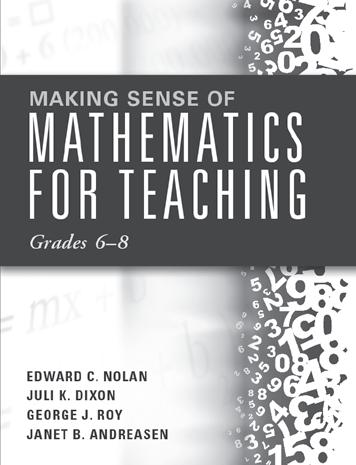

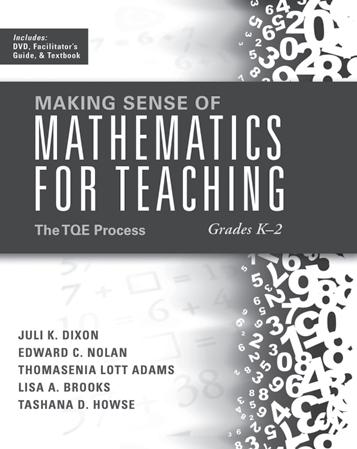
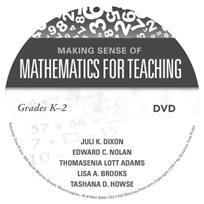
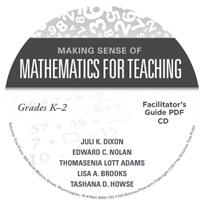

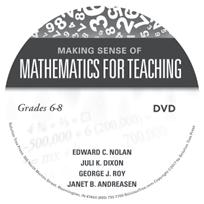
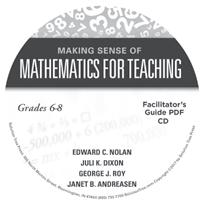
Making Sense of Mathematics for Teaching Grades K–2
Juli K. Dixon, Edward C. Nolan, Thomasenia Lott Adams, Lisa A. Brooks, and Tashana D. Howse
Develop a deep understanding of mathematics. With this user-friendly resource, grades K–2 teachers will explore strategies and techniques to effectively learn and teach significant mathematics concepts and provide all students with the precise, accurate information they need to achieve academic success.
BKF695
Making Sense of Mathematics for Teaching Grades 6–8
Edward C. Nolan, Juli K. Dixon, George J. Roy, and Janet B. Andreasen
Develop a deep understanding of mathematics. With this user-friendly resource, grades 6–8 teachers will explore strategies and techniques to effectively learn and teach significant mathematics concepts and provide all students with the precise, accurate information they need to achieve academic success.
BKF697
Making Sense of Mathematics for Teaching High School
Edward C. Nolan, Juli K. Dixon, Farshid Safi, and Erhan Selcuk Haciomeroglu
Develop a deep understanding of mathematics. With this user-friendly resource, high school teachers will explore strategies and techniques to effectively learn and teach significant mathematics concepts and provide all students with the precise, accurate information they need to achieve academic success.
BKF698
Making Sense of Mathematics for Teaching Grades K–2: The TQE Process
Juli K. Dixon, Edward C. Nolan, Thomasenia Lott Adams, Lisa A. Brooks, Tashana D. Howse
This video program will help educators develop a deeper understanding of mathematics and more effectively provide mathematics instruction in grades K–2. Included is the companion paperback book, Making Sense of Mathematics for Teaching Grades K–2.
DVF067
Making Sense of Mathematics for Teaching Grades 6–8: The TQE Process
Edward C. Nolan, Juli K. Dixon, George J. Roy, and Janet B. Andreasen
This multimedia workshop helps create a shared vision of classrooms where teachers and students are engaged in meaningful mathematics learning experiences.
DVF069
Visit SolutionTree.com or call 800.733.6786 to order.
Video Content Bonus Online Video Content Bonus Online Video Content
DIG DEEP INTO CONTENT
DIXON NOLAN ADAMS MATHEMATICS
Bring Dixon Nolan Adams Mathematics experts to your school







Our Services
1. Big-Picture Shifts in Content and Instruction
Janet B. Andreasen
Guy Barmoha
Lisa Brooks
Kristopher Childs
Craig Cullen
Brian Dean
Lakesia L. Dupree
Jennifer Eli
Erhan Selcuk Haciomeroglu
Tashana Howse
Stephanie Luke
Amanda Miller
Samantha Neff
George J. Roy
Farshid Safi
Jennifer Tobias
Taylar Wenzel

Introduce content-based strategies to transform teaching and advance learning.
2. Content Institutes
Build the capacity of teachers on important concepts and learning progressions for grades K–2, 3–5, 6–8, and 9–12 based upon the Making Sense of Mathematics for Teaching series.
3. Implementation Workshops
Support teachers to apply new strategies gained from Service 2 into instruction using the ten high-leverage team actions from the Beyond the Common Core series.
4. On-Site Support


Discover how to unpack learning progressions within and across teacher teams; focus teacher observations and evaluations on moving mathematics instruction forward; and support implementation of a focused, coherent, and rigorous curriculum.

▶
Juli K. Dixon
Thomasenia
Lott Adams
Edward C. Nolan
Pasco County School District | Land O’ Lakes, FL Demographics •4,937 Teachers •68,904 Students •52% Free and reduced lunch Discovery Education Benchmark Assessments Grade EOY 2014 % DE EOY 2015 % DE 2 49% 66% 3 59% 72% 4 63% 70% 5 62% 75%
Evidence of Effectiveness
The River Ridge High School Geometry PLC went from ninth out of fourteen high schools in terms of Geometry EOC
2013–2014 to rst out of fourteen high schools in Pasco County, Florida, for the 2014–2015 school
Katia Clouse, Geometry PLC leader, River Ridge High School, New Port Richey, Florida Contact your local representative 888.409.1682
pro ciency in
year.”























